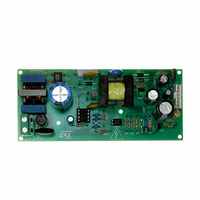STEVAL-ISA029V1 STMicroelectronics, STEVAL-ISA029V1 Datasheet - Page 17

STEVAL-ISA029V1
Manufacturer Part Number
STEVAL-ISA029V1
Description
BOARD EVAL BASED ON VIPER53-E
Manufacturer
STMicroelectronics
Series
VIPER™r
Type
MOSFET & Power Driverr
Specifications of STEVAL-ISA029V1
Design Resources
STEVAL-ISA029V1 Gerber Files STEVAL-ISA029V1 Schematic STEVAL-ISA029V1 Bill of Material
Main Purpose
AC/DC, Primary Side
Outputs And Type
3, Isolated
Power - Output
13W
Voltage - Output
12V, 3.3V, -24V
Current - Output
1A, 100mA, 40mA
Voltage - Input
85 ~ 300VAC
Regulator Topology
Flyback
Frequency - Switching
60kHz
Board Type
Fully Populated
Utilized Ic / Part
VIPer53
Input Voltage
85 V to 300 V
Output Voltage
12 V
Product
Power Management Modules
Silicon Manufacturer
ST Micro
Silicon Core Number
VIPer53-E
Kit Application Type
Power Management
Application Sub Type
Power Supply
Kit Contents
Board
Rohs Compliant
No
Lead Free Status / RoHS Status
Lead free / RoHS Compliant
For Use With/related Products
VIPer53-E
Other names
497-6458
STEVAL-ISA029V1
STEVAL-ISA029V1
VIPer53 - E
6
Secondary feedback configuration example
When a more accurate output voltage is needed, the way is to monitor it directly secondary
side, and drive the PWM controller through an optocoupler as shown on
The optocoupler is connected in parallel with the compensation network on the COMP pin.
The design of the auxiliary winding that the VDD voltage is always lower than the internal
15V reference. The internal error amplifier will therefore be saturated in the high state, and
because of its transconductance nature, will deliver a constant biasing current of 0.6mA to
the optotransistor. This current does not depend on the compensation voltage, and so it
does not depend on the output load either. Consequently, the gain of the optocoupler
ensures consequently a constant biasing of the TL431 device (U3) which is in charge of
secondary regulation. If the optocoupler gain is sufficiently low, no additional components
are required to ensure a minimum current biasing of U3. Also, the low biasing current value
avoid any ageing of the optocoupler.
The constant current biasing can be used to simplify the secondary circuit: Instead of a
TL431, a simple zener and resistance network in series with the optocoupler diode can
insure a good secondary regulation. As the current flowing in this branch remains constant
for the same reason as above, typical load regulation of 1% can be achieved from zero to full
output current with this simple configuration.
Figure 19. Off line power supply with optocoupler feedback
AC IN
F1
R1
C1
C4
R3
C5
OSC
T1
VIPer73
U1
15V
TOVL
VDD
R9
1k
C6
D1
10nF
C11
COMP
R4
SOURCE
R5
C7
C2
DRAIN
Secondary feedback configuration example
C3
D2
D3
R2
T2
D4
U2
U3
C10
C8
R8
Figure 17.
L1
C12
R7
R6
C9
17/36
DC OUT



















